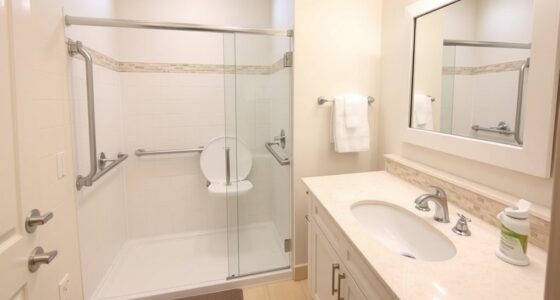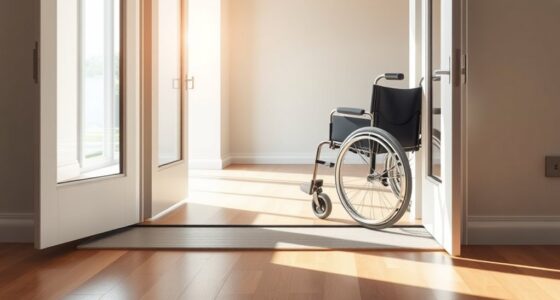Non-slip flooring options improve safety by increasing surface friction to prevent slips and falls. Materials like rubber, textured vinyl, epoxy coatings, and safety tiles are popular choices, each offering different levels of grip and durability. Surface textures such as grooves, ridges, or embossed patterns create more contact points and disrupt water or oil flow, boosting traction. To discover which solutions suit your needs best and how surface texture influences slip resistance, keep exploring these safe flooring options.
Key Takeaways
- Non-slip flooring options include textured rubber, vinyl, safety tiles, and epoxy coatings designed to increase surface friction.
- Surface texture, such as grooved or embossed patterns, enhances grip by creating more contact points.
- Friction resistance is measured by the coefficient of friction, which varies with material, texture, and contaminants.
- Incorporating abrasive particles or anti-slip additives improves surface traction and reduces slip hazards.
- Proper surface preparation, maintenance, and application techniques are essential to ensure long-lasting slip resistance.
Understanding Friction and Its Role in Safety

Friction plays a crucial role in ensuring safety on flooring surfaces by providing the grip needed to prevent slips and falls. Static friction is what keeps you from slipping when you stand still, gripping your shoes to the floor. Hydrodynamic friction comes into play when there’s a thin layer of liquid, like water or oil, between your shoes and the surface—reducing grip and increasing slip risk. Understanding how static friction works helps you realize why textured or rough surfaces improve safety by increasing grip. Meanwhile, hydrodynamic friction explains why spills or wet floors are hazardous, as they lessen the frictional force. By focusing on these types of friction, you can better appreciate how different flooring materials and conditions impact safety and slip prevention.
Common Materials Used in Non-Slip Flooring

When selecting non-slip flooring, choosing the right materials is essential to guarantee safety and durability. Common options include rubber, textured vinyl, safety tiles, and epoxy coatings. Rubber offers excellent grip, resilience, and appealing flooring aesthetics, making it ideal for gyms or kitchens. Textured vinyl provides affordability and versatility, suitable for residential and commercial spaces. Safety tiles are highly durable with embedded abrasives, often used in industrial settings. Epoxy coatings create seamless, slip-resistant surfaces that resist chemicals and wear. Here’s a quick comparison:
| Material | Flooring Aesthetics & Cost Considerations |
|---|---|
| Rubber | Durable, good aesthetics, moderate cost |
| Textured Vinyl | Affordable, versatile, decent aesthetics |
| Safety Tiles | High durability, higher cost |
| Epoxy Coatings | Seamless, durable, moderate to high cost |
Additionally, understanding the friction properties of each material can help in selecting the most effective option for specific environments.
Textured Surfaces and Their Impact on Grip

Textured surfaces play a vital role in enhancing grip on non-slip flooring by increasing surface friction. When you walk on textured surfaces, the tiny grooves and ridges create more contact points between your shoes and the floor, leading to better grip enhancement. These textural features disrupt the smooth flow of water, oil, or other slippery substances, reducing the risk of slips and falls. Different textures, such as embossed patterns, grooved designs, or ribbed finishes, are tailored to specific environments for maximum safety. By choosing flooring with textured surfaces, you actively improve traction, especially in high-moisture or high-traffic areas. Overall, textured surfaces are an effective way to boost grip and guarantee safer footing.
The Science Behind Slip Resistance Ratings

Understanding slip resistance ratings starts with measuring friction coefficients, which indicate how well a floor resists slipping. Surface texture plays a significant role, as rougher surfaces generally increase traction. Additionally, choosing the appropriate headphone jack type can improve safety by ensuring secure connections and reducing the risk of accidental disconnections that could lead to hazards. By examining these factors, you can better assess which flooring options provide the safest grip.
Measuring Friction Coefficients
Measuring friction coefficients is essential for determining how well a flooring material resists slipping under various conditions. To do this, you rely on different friction measurement techniques, such as tribometers and slip testers, which simulate real-world scenarios. These devices assess the coefficient of friction (COF) by applying a force to a surface and measuring resistance. The resulting data helps you evaluate slip resistance ratings accurately. When conducting measurements, consider factors like surface contaminants, moisture, and footwear, as they influence results. Understanding these techniques enables you to compare flooring options objectively, ensuring you select surfaces with appropriate slip resistance. Additionally, familiarizing yourself with voiceover techniques can aid in creating engaging safety announcements or instructional videos about slip hazards. Ultimately, precise friction measurement is crucial for creating safe environments and minimizing slip-related accidents.
Impact of Surface Texture
Surface texture plays a crucial role in slip resistance by directly affecting how well a flooring material grips your footwear. Increased surface roughness creates more friction, improving slip dynamics and reducing the risk of slipping. Smooth surfaces tend to have lower slip resistance because they allow your shoes to slide more easily. Conversely, rough textures enhance grip, especially when wet or oily conditions are present. The microscopic peaks and valleys in the surface texture influence how footwear interacts with the floor, impacting slip resistance ratings. Understanding this relationship helps you choose flooring with the appropriate surface texture for your environment. Automation technologies enable scalability and flexibility in many industries, which can also influence the design and safety features of flooring materials. By considering surface roughness, you can optimize safety and minimize fall hazards in areas prone to moisture or high foot traffic.
Rubber Flooring: A Durable Non-Slip Solution

Rubber flooring stands out as a highly durable and slip-resistant choice for both commercial and residential spaces. Its textured surface provides excellent traction, reducing the risk of slips and falls. Plus, rubber flooring offers versatile flooring aesthetics, fitting modern or traditional decor seamlessly. It’s also environmentally sustainable, often made from recycled tires, which helps reduce waste. You can choose from various colors and patterns to match your style while maintaining safety. Durability means it withstands heavy foot traffic and equipment without deteriorating. Its resilience makes it ideal for gyms, kitchens, and play areas. The table below highlights key aspects of rubber flooring:
| Feature | Benefit |
|---|---|
| Flooring aesthetics | Wide variety of designs to match decor |
| Environmental sustainability | Made from recycled materials, eco-friendly |
| Material composition | Contributes to its durability and eco-friendliness |
Vinyl and Linoleum Options for Moisture-Prone Areas

When choosing flooring for moisture-prone areas like bathrooms and kitchens, vinyl and linoleum stand out as reliable, slip-resistant options. They offer excellent moisture resistance, making them ideal for damp environments. Plus, both materials come in a wide aesthetic variety, so you can match your decor effortlessly. Here are some benefits:
- Waterproof surfaces – Resisting spills and humidity keeps your floors safe.
- Slip-resistant textures – Many options include textured finishes for added safety.
- Low maintenance – Easy to clean and maintain, saving you time.
- Design flexibility – From bold patterns to subtle tones, you get diverse style choices.
Additionally, understanding safety considerations like slip resistance and proper installation helps ensure your flooring remains both attractive and safe over time. Vinyl and linoleum combine practicality with aesthetic appeal, making them top contenders for moisture-prone areas that require non-slip solutions.
Epoxy and Resin-Based Non-Slip Coatings

Epoxy and resin-based coatings are popular choices for adding slip resistance and durability to floors. Their material composition guarantees long-lasting performance when applied correctly and safely. By understanding their application techniques, you can effectively enhance slip resistance in high-traffic or wet areas. Additionally, knowing the importance of legal representation can help ensure proper installation and compliance with safety standards.
Material Composition and Durability
Considering their widespread use in high-traffic areas, epoxy and resin-based non-slip coatings are renowned for their exceptional material composition and durability. Their chemical composition includes strong polymers that resist abrasion and chemical wear, ensuring long-lasting performance. Fiber reinforcement plays a key role by adding tensile strength and preventing cracks under stress. The durability of these coatings depends on several factors:
- The quality of the resin and epoxy blend used
- The incorporation of fiber reinforcement to enhance tensile strength
- Resistance to chemicals, oils, and water exposure
- Proper curing processes that optimize hardness and adhesion
These elements work together to create a resilient, non-slip surface that withstands heavy foot traffic and harsh conditions, making them a reliable choice for durable flooring solutions.
Application Techniques and Safety
Applying epoxy and resin-based non-slip coatings requires careful preparation and adherence to safety protocols to guarantee ideal results. Before starting flooring installation, confirm the surface is clean, dry, and free of debris to promote proper adhesion. Follow safety protocols by wearing protective gear such as gloves, goggles, and masks to prevent exposure to fumes and chemicals. Mix the components precisely according to manufacturer instructions, and apply the coating evenly using brushes, rollers,, or sprayers. Work in well-ventilated areas to minimize inhalation risks. Avoid rushing the process; proper application ensures durability and slip resistance. Once applied, allow sufficient curing time before foot traffic. Additionally, understanding the sound vibrations involved in sound therapy can help in selecting appropriate materials that enhance overall health benefits. By observing these safety protocols and thorough application techniques, you ensure a safe, effective, and long-lasting non-slip flooring solution.
Slip Resistance Enhancement
Enhancing slip resistance with epoxy and resin-based coatings involves adding textured aggregates or specialized additives to the mixture, which substantially improve traction on the surface. This method is a key part of slip prevention strategies during flooring installation. To maximize effectiveness, consider these approaches:
- Incorporate abrasive particles like quartz or silica for increased grip.
- Use textured or anti-slip additives tailored for specific environments.
- Apply coatings evenly to ensure consistent slip resistance across the surface.
- Regularly maintain and reapply coatings to sustain slip resistance over time.
- Understand the importance of surface preparation to ensure proper adhesion and long-lasting slip resistance.
Innovations in Non-Slip Flooring Technology

Recent advances in non-slip flooring technology have considerably improved safety without compromising style or durability. You now have access to smart flooring options that incorporate sensors to monitor foot traffic and slip risks, enhancing safety dynamically. Additionally, innovative materials are making eco-friendly options more practical and attractive. These eco-friendly floors use sustainable resources like recycled rubber or plant-based polymers, reducing environmental impact while maintaining high friction levels. Manufacturing processes have also evolved to produce textured surfaces that resist slips without sacrificing aesthetics. You can now choose flooring solutions that combine advanced safety features with eco-conscious design, ensuring your space remains safe, stylish, and sustainable. Moreover, preppy-inspired designs are being integrated into modern flooring styles, blending elegance with safety features. These technological improvements mean you don’t have to compromise on safety for the sake of appearance or environmental responsibility.
Tips for Maintaining and Enhancing Slip Resistance

Maintaining and enhancing slip resistance is essential to keep your floors safe over time, especially in high-traffic areas. Regular cleaning prevents buildup that can reduce friction, preserving safety and aesthetic appeal. To boost slip resistance effectively, consider these tips:
Regular cleaning and inspections are key to maintaining slip-resistant floors over time.
- Use appropriate cleaning products that don’t compromise the flooring’s textured surface or ergonomic design.
- Apply non-slip coatings or treatments periodically to restore friction and improve safety.
- Select flooring options with integrated slip-resistant features that complement your space’s aesthetic appeal.
- Inspect regularly for wear and tear, replacing or repairing damaged areas promptly to maintain consistent slip resistance.
Frequently Asked Questions
How Do Environmental Conditions Affect Non-Slip Flooring Performance?
Environmental conditions markedly impact non-slip flooring performance. Humidity effects can make surfaces more slippery if they trap moisture, reducing traction. Temperature fluctuations cause materials to expand or contract, which may lead to cracks or uneven surfaces that decrease grip. You should regularly monitor these conditions and choose flooring designed to withstand specific environments, ensuring safety and durability despite humidity effects and temperature changes.
Are There Eco-Friendly Non-Slip Flooring Options Available?
Yes, eco-friendly non-slip flooring options are available. You can choose sustainable materials like cork, bamboo, and recycled rubber, which offer excellent traction and reduce environmental impact. These options are durable, safe, and eco-conscious, making them ideal for spaces prioritizing sustainability. By selecting eco-friendly materials, you contribute to environmental preservation while ensuring safety and slip resistance in your flooring choices.
Can Non-Slip Flooring Be Customized for Aesthetic Purposes?
Yes, non-slip flooring can be customized for aesthetic purposes, turning your space into a canvas of your dreams. You can choose from a variety of color options and incorporate custom designs that reflect your style. Like a painter with a blank canvas, you have the freedom to blend textures, patterns, and hues, ensuring your flooring isn’t just safe but also a stunning focal point that complements your overall decor.
What Is the Lifespan of Different Non-Slip Flooring Materials?
Your non-slip flooring’s lifespan depends on the material and maintenance routines. For example, vinyl and rubber often last 5-10 years with proper durability testing and regular cleaning, while textured concrete can endure 15-20 years if well-maintained. Consistent upkeep, such as cleaning and prompt repairs, extends its life. By following recommended maintenance routines, you guarantee your non-slip flooring remains safe and functional for years to come.
How Do Cleaning Routines Impact the Slip Resistance of Flooring?
Think of cleaning routines as your flooring’s workout; they keep it in top shape. Regular cleaning maintenance removes surface contamination that can make floors slippery. If you neglect this, dirt and spills build up, reducing slip resistance and turning your floor into a skating rink. To keep it safe, sweep and mop frequently, using appropriate cleaners, ensuring your flooring remains grip-friendly and prevents accidents.
Conclusion
By choosing the right materials, maintaining textured surfaces, and staying informed about slip resistance ratings, you create a safer environment. Think of your flooring as a steady foundation, a reliable grip, and a resilient shield against slips. With ongoing innovations and proper upkeep, you guarantee safety, confidence, and peace of mind. Your flooring becomes not just a surface, but a safeguard—steady, secure, and slip-free, ready to support every step you take.









